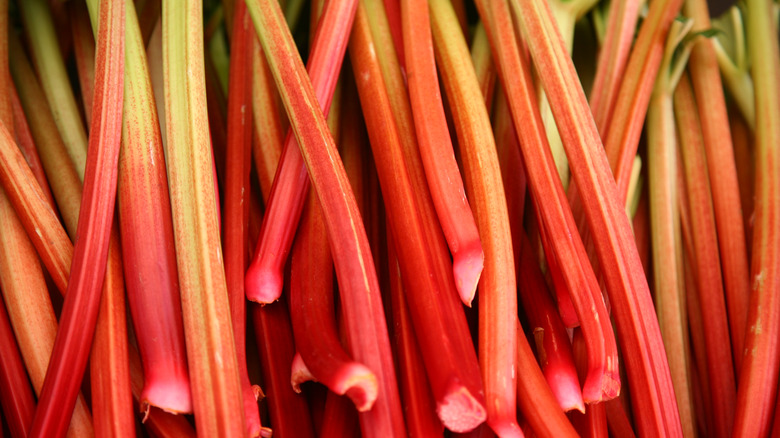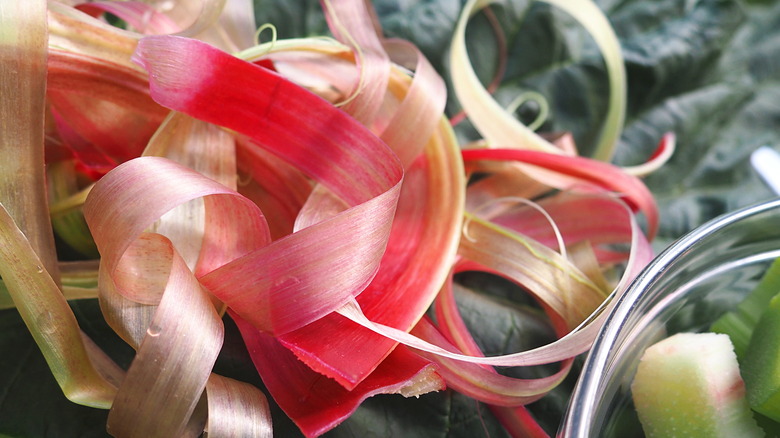Peel Rhubarb Into Ribbons For A Sweet Twist On A Nostalgic Candy
Happy rhubarb season to all who celebrate. This is the time when electric pink and green stalks flood the farmers market, and bakers begin breaking out their favorite early summer recipes. Yes, the vegetable that grows so fast that you can hear it actually adds tartness to pies, cocktails, jams, and even a can't-miss burrata dish in Chicago.
The pretty vegetable shines when pickled and baked, but there's another creative way to prepare it. Try giving thin strips of the stalk a sugary coating to create sour ribbon candies. These may just remind you of the Haribo sour streamers and candy belts of your youth.
@ainslieadrian RHUBARB SOUR BELT CANDY 🍭 So simple to make and so delicious. Harvested from our farm #rhubarb #rhubarbcandy #fyp #rhubarbseason #farmfresh #rhubarbrecipes
The process is easy and only requires two ingredients: rhubarb and sugar. To make them, peel vertical strips off the stalks (being sure to discard the leaves, as they are toxic) using a mandoline or vegetable peeler. Then dip the strips in sugar, set them on a baking sheet lined with parchment paper, and cook for anywhere from 20 to 45 minutes depending on your oven temperature. Once they start to release their syrup, remove them from the heat, dip each one in granulated sugar, and enjoy.
Tips for making tasty rhubarb candy
Different households have their own quirks and preferences when it comes to making this homey snack. Some people douse their ribbons in sugar before and after baking. Others have strong opinions about low-and-slow roasting to ensure the rhubarb is tender and juicy. Of course, to ensure the best candy possible, follow a few handy tips.
First, make sure the ribbons are thin and uniform to make it easier to cook them through. Some cooks prefer to use the longest possible stalks, peels and all, to make lengthy pink and green strips, but this isn't essential. Technically, you can even make these with wedges of chopped rhubarb, but cooks tend to prefer the ribbons as they bake into sweeter candy. The heat penetrates less of the chunky bite's interior, resulting in more of a pucker-inducing sour belt.
Rhubarb contains high quantities of malic and oxalic acid, making it one of the sourest pieces of produce you'll find. That means it needs no citric acid or additional sour flavorings that other candies require. As such, this can make the resulting ribbons mouthwateringly tart, but a bit one-note. Once you get the hang of the process, don't be afraid to add seasonings. A quick dip in lemon or lime juice before cooking can heighten the zingy experience while spiced sugar rubs made with cinnamon, lavender, vanilla, or cardamom can add complexity.
Candied rhubarb goes savory and sweet
The strips aren't just good for mimicking sour candy belts. Cook the floppy rhubarb about double the time, and you can produce crisped ribbons that hold their shape and make elegant additions to a cocktail glass. To achieve a corkscrew shape, wrap the strips around chopsticks or a wooden spoon right after they cook to set their shape. If you forget and leave them for too long in the oven (or about three hours in the dehydrator), don't sweat it. Your household will have rhubarb leather to snack on instead.
Rather than making these with sugar rubs, you can whip up candied rhubarb with a five-minute soak in simple syrup before cooking. Simple syrups, made of water and sugar, are a wonderful vehicle for additional flavorings. Consider using juniper, rosemary, rose, or cayenne pepper to infuse the rhubarb.
The dried ribbons make excellent garnishes for sweet cakes, savory foods, and cheese courses as well as a garnish for booze. Consider preparing your sugar-soak with seasonings that complement the rest of your meal. Though it may take some trial and error, salty or spicy additions to the mixture can balance out the sweetness. This is a chance to use peppercorns, ginger, and lemongrass to sharpen the mix. Or dust the final product with togarashi or sal de gusano, an ingredient that typically pairs well with citrus and tequila, for a savory candied bite.



